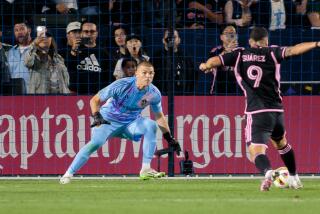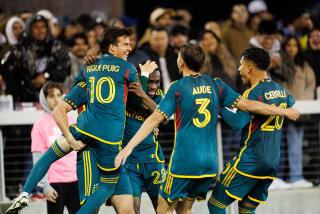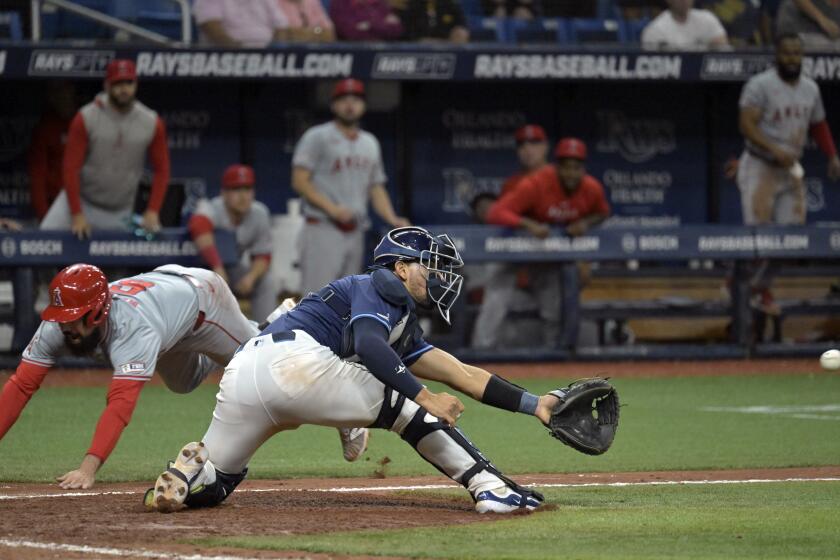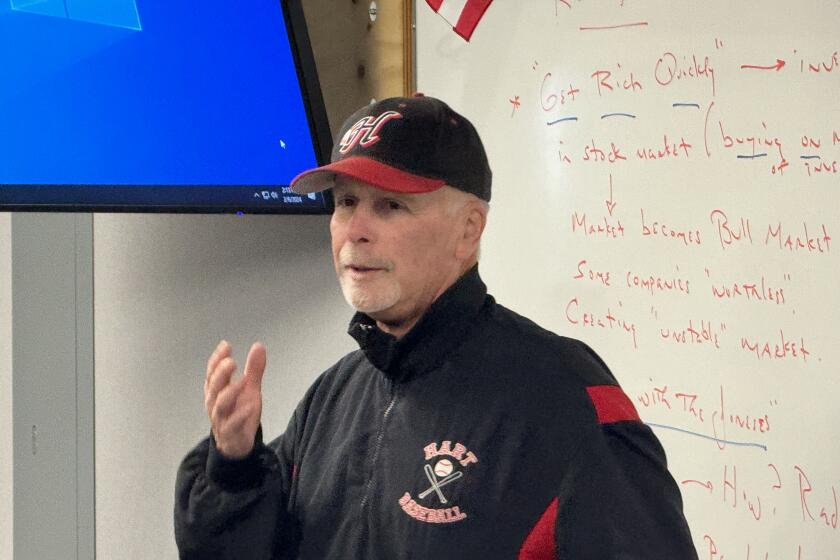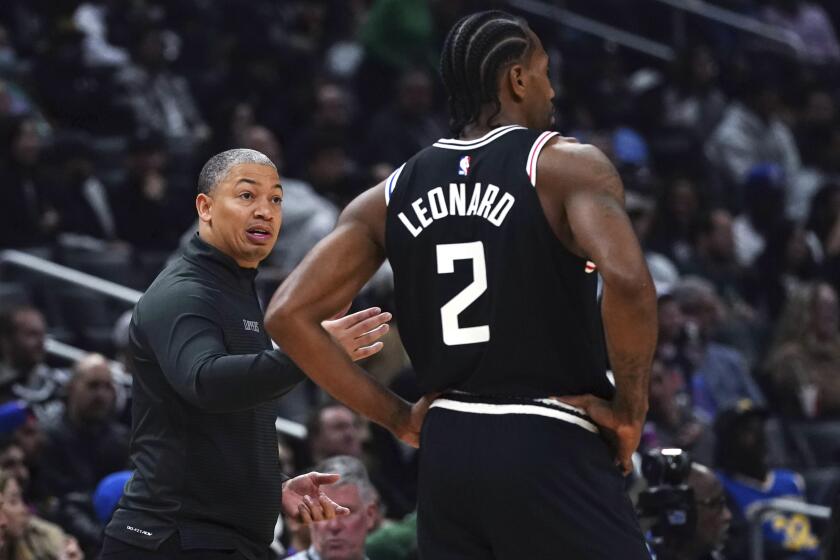Soccer newsletter: Seattle Sounders were built to win the MLS Cup

Hello and welcome to another edition of the L.A. Times soccer newsletter. I’m Kevin Baxter, the Times’ soccer writer.
The MLS season is over and we have a new champion – one that is also an old champion since Seattle’s win over Toronto in Sunday’s final gave the Sounders their second title in four years. But Garth Lagerwey, the man who built the roster as the Sounders’ general manager, said this year’s team was different from the rest
“From the beginning of the season we said a couple of things,” Lagerwey said. “We said we thought this was the best Sounders team of all time. We said we’re at the mature part of our cycle, which is to say we had our money invested in big-time [designated players] in their prime.
“We had a bunch of other players in their prime and that’s really important that we win now. We shoved all our chips into the middle of the table.”
That bet paid of big with a 3-1 win that, from the perspective of Sounders’ fans, was far more effective than it was attractive.
There were a lot of Sounders fans there, too, with the crowd of 69,724 setting a record for the largest sports crowd in the history of CenturyLink Field, a stadium the Sounders share with the NFL’s Seahawks.
It was also the second-largest crowd in MLS Cup history, trailing only the 73,019 that turned out for last year’s game at Mercedes-Benz Stadium in Atlanta.
And for the most part they saw a game Toronto dominated, holding the ball for nearly 60 of the 90 minutes and completing more than twice as many passes as Seattle. But a goal by Kelvin Leerdam, on a shot that caromed off two defenders on its way into the net, broke open a scoreless duel early in the second half and allowed Seattle to overcome all of that.
“Gut punch,” said Jozy Altidore, who came off the bench to score Toronto’s only goal in stoppage time. “No other way to put it. We took the game to them, we had most of the play throughout the game, but football is 90 minutes.
“We switched off and they got a lucky goal.”
Even if the goal was lucky, everything else the Sounders did this season was by design. At least the part Lagerwey had control over anyway.
His first designated player, Nicolas Lodeiro, joined the team midway through the 2016 season and took it to its first MLS title. The other DP, Raul Ruidiaz, joined the team last season. They had a hand in all three scores Sunday, combining for a goal and two assists.
While GMs in places such as Chicago, New York and Southern California have felt pressured to sign big-name DPs to compete for fans in crowded sports markets, Lagerwey says he hasn’t faced that kind of pressure from his fans.
“They want to see good soccer. And they’re less interested in the star power,” Lagerwey said. “What it allows us to do is to spend efficiently. We can get the best player we can afford for our money and then turn them loose.”
So while Seattle’s guaranteed payroll of $12.5 million was sixth-highest in MLS, Toronto spent nearly that much just on U.S. national team stars Altidore and captain Michael Bradley. Lagerwey, meanwhile, spread his money out with only Lodeiro and Ruidiaz drawing base salaries of more than $1 million -- but 11 others making at least $500,000.
“Our fans will embrace anybody who’s a star for the Sounders,” he said. “That may not help in the national recognition column but our fan base is perfectly fine with that.”
Lagerwey was also content to finish second in the conference standings, conceding the Supporters’ Shield to LAFC, which was five wins and 16 points better than Seattle during the regular season. Since 2002 only three teams have been best during the 34-game marathon of an MLS regular season and the league’s playoff sprint and that pattern followed form in 2019 when the Sounders beat LAFC, on its own turf, in the playoffs.
That gave them the right to host the MLS Cup final, before nearly 70,000 fans, in their own stadium, where they had a 12-game unbeaten streak. The game sold out in less than 30 minutes.
“There were some nerves there in the first half. There were some plays where guys needed to be a little bit more composed,” said Sounders coach Brian Schmetzer, who has spent nearly his entire soccer career in Seattle, playing youth soccer under his father with the Lake City Hawks, in the NASL with the old Seattle Sounders, then coaching with the Sounders and Tacoma Stars before joining the first MLS coaching staff in Seattle as an assistant when the Sounders joined MLS in 2009.
Sunday’s game was easily the biggest the Sounders have played in Seattle and Leerdam’s goal in the 57th minute changed everything, allowing the team to settle down while Toronto had to open up to chase the game. And that allowed Victor Rodriguez to come off the bench and double Seattle’s lead in the 76th minute. Ruidiaz made it 3-0 at the end of regulation before Altidore scored to ruin Stefan Frei’s shutout.
But it didn’t upset Lagerwey’s carefully crafted plan.
“The rules say that the champion is the MLS Cup winner,” he said a couple of days before the game. “Turns out there seems to be a lot of logic is building a team that can win playoff games and win titles.”
Will a called strike keep everyone out?
The 2019 MLS season ended with Sunday’s title game and no one can say for certainty when the next one will begin.
The first games of 2020 are scheduled for late February but the league’s collective bargaining agreement with its players expires before then and the union says it is prepared to strike if it doesn’t get what it wants in a new deal.
“It is not our goal. But we are certainly prepared if it becomes a reality,” Bob Foose, executive director of the players’ association, said in a conference call last week.
Foose said the current CBA, which expires Jan. 31, has brought unprecedented growth to the league, which had added nine teams while the average non-designated player salary has doubled, to more than $350,000. A record 55 players made at least $1 million this season.
The two sides have been talking for months about a new deal but they remain far apart on three contentious issues: free agency, targeted allocation money and charter flights.
Five years ago the players agreed to a narrow free agency that applied only to players who are at least 28 years old, have played in the league for at least eight seasons and are out of contract. And because MLS is a single-entity structure, it also demanded there be limits on how much teams could pay free agents since the league would essentially be negotiating against itself.
This winter the players want to loosen many of those restrictions.
“We want to see substantial progress made toward a system of true, unrestricted free agency at a much earlier point in players’ careers,” Foose said.
The union sees targeted allocation money, which comes with rules over how it can be spent, as unnecessarily restrictive and wants to make that funding available equally to all players.
“The impact of TAM, a made-up set of restrictions done from a central office to try to dictate to all of our franchises how they build their rosters, didn’t really add anything to the league,” Foose said. “TAM is silly. It is not necessary to tell our front offices how to sign players.
“Things like TAM need to go away and we need to stop being a league where there is an over-centralization, where there is an over-tinkering and where there’s this notion that you design a competitive football league in a boardroom.”
The union also wants to lift restrictions on charter flights. The current CBA limits teams to four charter flights a season, with the league, which subsidizes travel, citing costs as a reason. But giving the teams a choice of how to fly could result in some paying for unlimited charters while others travel commercial, and that would affect the league’s competitive balance.
The players, conversely, see a lack of charters as already affecting the play on the field. MLS is the only professional sports league in the U.S. and Canada that continues to use commercial flights. That often forces teams to spend an extra night on the road, costing them training days. Teams are also routinely hampered by flight delays and cancellations, problems that could increase with the team expanding to Nashville, Sacramento, Austin and, perhaps, Charlotte, cities with smaller airports and limited commercial routes.
“It’s not just about skipping the line and getting a better meal,” said Philadelphia Union midfielder Alejandro Bedoya, who blamed an injury this season on a cross-country commercial flight. “There’s been research about how it improves recovery time. We talk about a league trying to become one of the better ones and increasing quality. Charter travel is important.”
Added Atlanta United midfielder Jeff Larentowicz, a member of the MLSPA’s executive board: “This is one piece of the pie for us. A very important piece. And probably a commonsense piece.”
MLS commissioner Don Garber, in comments published by the Associated Press, did not address the possibility of a strike but called the ongoing talks “productive.”
MLS training camps will open in mid January, about two weeks before the current CBA expires and if there is no new accord, the union and the league must agree to continue operating under the old rules. If the players don’t agree, there could be a walk out; if the owners don’t agree there could be a lockout.
That makes Feb. 18 a date that could indicate how talks are going. The CONCACAF Champions League opens that day with five MLS teams – Atlanta United, LAFC, Seattle, New York City FC and Montreal – in the field. If the players are unhappy with the negotiations, they could decide not to take part in the tournament, which could prove a costly embarrassment to the league.
“What the consequence to that would be is unclear,” Foose said. “We certainly hope it doesn’t come to that. But that’s a possibility.”
The MLS offseason schedule
Nov. 13: Trade window, which opened Monday, closes.
Nov. 14: Deadline to make contract extension offers to players.
Nov. 16: List of players available in expansion draft is released. D.C. United, Vancouver, Dallas, Houston and the New York Red Bulls, who lost players to Cincinnati in last year’s expansion draft, do not have to make players available. The other 19 returning MLS clubs can protect 12 players from their senior, supplemental and reserve rosters.
Nov. 19: Expansion draft with Inter Miami and Nashville selecting as many as five players each, only one of which can come off an existing team.
Nov. 21: Deadline for clubs to exercise contract options.
Nov. 22: List of free agents are released. Free-agency eligible players are out-of-contract and option-declined players who are at least 28 and have a minimum of eight years of MLS service time.
Nov. 22: List of players eligible for re-entry, stage 1 is released.
Nov. 25: Waivers are conducted on players who are out of contract and free agency opens.
Nov. 26: Re-entry process, Stage 1.
Dec. 3: Re-entry process, Stage 2.
Dec. 9: CONCACAF Champions League draw is held. LAFC is among the teams participating
Mid-January: MLS teams participating in the CONCACAF Champions League open training camp, about a week earlier than the rest of the league.
Jan. 31: Collective Bargaining Agreement between MLS and MLS Players Association expires.
Feb. 18-20: First round of Champions League games.
Feb. 25-27: Second round of Champions League games.
Late February: MLS regular season opens
Pregnant with possibilities
Carli Lloyd was unhappy with her role in last summer’s Women’s World Cup, where she backed-up center forward Alex Morgan, and she hinted she might retire this fall rather than push through to next year’s Tokyo Olympics.
Well, don’t order that rocking chair just yet. With Morgan off on maternity leave until late spring, making her availability for the Olympics uncertain, Lloyd, 37, is back in the starting lineup and she rewarded new coach Vlatko Andonovski with three goals and an assist in wins over Sweden and Costa Rica to end the year.
The goals gave Lloyd 121 in her national team career and a team-high 16 for 2019. That’s her third-highest single-season total and it marks the third time in five years she has let the team in scoring in a calendar year.
She had a U.S-best 18 goals in 2015 and 17 in 2016.
James Galanis, Lloyd’s personal coach, said the player’s decision about her future would ultimately hinge on who replaced Jill Ellis as coach after Ellis, who led the U.S. to two world championships, stepped down last month. And two games into Andonovski’s tenure, Lloyd and Galanis appear happy, if cautious, about the change.
“Taking it day by day,” Galanis said last week.
The U.S. finished the year 20-1-3 record this year – including seven wins in as many games in last summer’s World Cup -- marking the 12th time in 35 years the team has won 20 or more games in a calendar year.
The road to Tokyo starts in Carson
Before the U.S. women can set their sights on a fifth Olympic gold medal they have to qualify for the tournament. They can do that in early February at Dignity Health Sports Park, which has played host to more U.S. women’s national team games than any stadium in the world.
The U.S. is 14-0 in Carson, where it has outscored opponents 53-4.
To get there, the Americans will have to finish first or second in their group in the eight-team CONCACAF Olympic qualifying tournament, which includes Costa Rica, Panama and Haiti. Round-robin group play will open Jan. 28 in Houston.
The other four-team group, made up of Canada, Mexico, Jamaica and Saint Kitts and Nevis, will kick off Jan. 29 in Edinburg, Texas. The top two finishers in each group will advance to the semifinals Feb. 7 in Carson with the two semifinal winners moving on to both the Feb. 9 final and the Summer Games.
Half of the 12-team Olympic field is already set with host Japan, Brazil, Great Britain, the Netherlands, Sweden and New Zealand already in.
The top-ranked U.S. was eliminated by Sweden in the quarterfinals of the 2016 Rio Olympics, the team’s earliest-ever exit. The Americans made it to the gold-medal game of the first five Olympic tournaments, winning the title four times.
No. 7 Canada, meanwhile, has won bronze medals in each of the last two Olympic tournaments.
Ticket information, kickoff times and TV information for the qualifying tournament will be released at a later date.
Tournament schedule
Group A
BBVA Stadium, Houston
Jan. 28
Costa Rica-Panama, U.S.-Haiti
Jan. 31
Haiti-Costa Rica, Panama-U.S.
Feb. 3
Panama-Haiti, U.S.-Costa Rica
Group B
HEB Park, Edinburg, Texas
Mexico-Jamaica, Canada-Saint Kitts and Nevis
Feb. 1
Saint Kitts and Nevis-Mexico, Jamaica-Canada
Feb. 4
Jamaica-Saint Kitts and Nevis, Canada-Mexico
Semifinals
Dignity Health Sports Park
Carson, Calif
Feb. 7
1B vs 2A, 1A vs. 2B
Feb. 9
Final
So you want to be a pro soccer player?
Speaking of women’s soccer, if you want to play the sport as a professional you had better start saving. Here are the minimum and maximum salaries in the National Women’s Soccer League, as reported by journalist John D. Halloran.
2020: $20,000/$50,000
2019: $16,538/$46,200
2018: $15,750/$44,000
2017: $15,000/$41,700
2016: $7,200/$39,700
2015: $6,842/$37,800
2014: $6,600/$31,500
2013: $6,000/$30,000
These are professionals, mind you – the best in the world at what they do. And they trained their whole life to do it. Yet next season the minimum salary for a NWSL player would be $4,960 less than the minimum wage for a full-time worker in California.
And this is after the NWSL increased its salary cap to $650,000, up from $421,500 in 2019.
National team players subsidized by the U.S. and Canadian federations receive much higher wages, paid for by the federations, but that could change since U.S. Soccer – which has contributed $18 million to the league in its first seven season – is ending its formal operating agreement with NWSL.
Quotebook
“This is the most fun I’ve had in coaching. It really is a lot of fun and it’s the best facility I’ve had. That part’s great. We’re going to have a better team next year. We’re headed in the right direction.”
New England Revolution coach Bruce Arena on the opening of the team’s new $35-million training facility and the outlook for next season
Until next time
Stay tuned for future newsletters. Subscribe here, and I’ll come right to your inbox. Something else you’d like to see? Email me. Or follow me on Twitter: @kbaxter11.
More to Read
Get our high school sports newsletter
Prep Rally is devoted to the SoCal high school sports experience, bringing you scores, stories and a behind-the-scenes look at what makes prep sports so popular.
You may occasionally receive promotional content from the Los Angeles Times.

